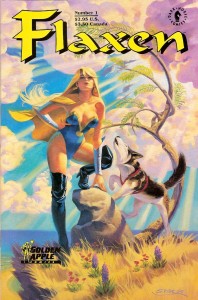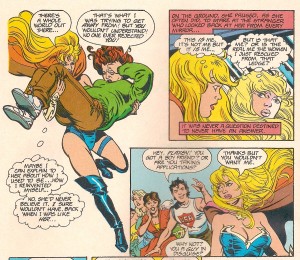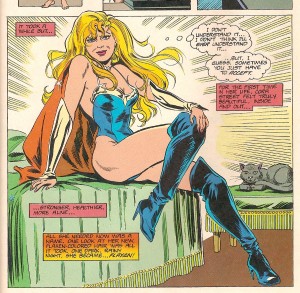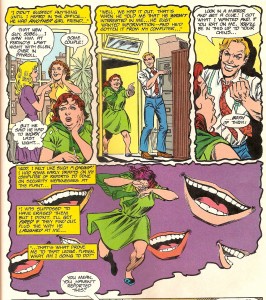
 Two years ago, I did a series of Vault posts over on Frazier’s Brain about comic book heroes based on real-life people. It was inspired by seeing Tim Burgard in the credits of a movie and realizing I had some comics with his work in them.
Two years ago, I did a series of Vault posts over on Frazier’s Brain about comic book heroes based on real-life people. It was inspired by seeing Tim Burgard in the credits of a movie and realizing I had some comics with his work in them.
But at the time, the comic I originally intended to lead the series off with–the Dark Horse comic, Flaxen–was still buried in the Vault. Now at last it has been unearthed so that you can see the awesomeness of the original comic whose legacy was ruined by the wretched sequel.
Flaxen started out as a logo/mascot for Golden Apple Comics in Los Angeles. And when Playboy Playmate Susie Owens was in the store to sign some posters, the owner of the shop asked her to model as the character, which led to personal appearances and photo shoots, and finally to a special edition comic put out by Dark Horse and Golden Apple Comics.
So let’s dig into this thing and see how much more awesome it was than the sequel. It certainly starts off on the right foot, with a cover by Steve Rude featuring both Flaxen and Jesse the wolf-dog. So let’s check out the story.
It’s written by Mark Evanier (who had a long career in TV animation and fan writing, and also wrote DNAgents and Crossfire) and pencilled by Richard Howell. Who? Well, he also did some illustrations for the Handbook of the Marvel Universe and worked on a Hawkman series nobody read and… Hell, I don’t know. Hollywood storyboard artist Tim Burgard and comics legend Jim Mooney did the inking.
The story opens with Flaxen racing to rescue a woman who’s on a skyscraper ledge, threatening to jump. She flies up and saves the woman, who does not particularly want to be saved. She is upset because she’s fat and homely, but she knows someone like Flaxen could never understand. But Flaxen can actually sympathize.
“It was never a question destined to never have an answer.” I read that sentence over several times and I’m still not sure what it means. Â It’s almost physically painful to read.
Anyway, the point of that interlude was to let us know two things: Flaxen’s main power is how hot she is, and her principal weakness is that she can’t believe how hot she is. Seriously.
Now we flash back to Flaxen’s origin. She was simple Cora Street, an overweight homely nurse with a heart of gold. Her favorite patient was a young boy named Andy who was desperately waiting for a heart transplant, if only a heart his size would become available. One night, Cora witnesses an auto accident. She runs to help, saving the father and displaying impressive strength to try to save the son, but she’s too late. The son dies, and she immediately talks the father into donating the boy’s heart to save Andy, convincing him with her caring and compassion.
The doctors rush Andy into surgery, but a storm strikes and the hospital loses power. Cora rushes down to turn on the emergency generator, but as she flips the switch to restore power, lightning strikes, and Cora receives a huge shock. She survives, but it makes her feel funny.
She then spends two full pages, 9 panels apiece, looking at herself in a mirror, watching herself switch back and forth from homely to beautiful while moaning about how an ugly girl like herself can never change. Eighteen full panels of this monotonous whining, and holy God, is it boring.
She finally decides to believe it and transforms into Flaxen. Â The first thing she does with her new hotness is sew up a revealing outfit for herself, cause why not?
What the hell is that in the background. A cat? Where the hell is Jesse, the awesome wolf-dog? This comic sucks.
So Flaxen apparently also has super-powers, like flight and super-strength and stuff, because she starts rescuing people, but the main thing is, she looks good doing it. Pause for centerfold.
That’s right. In a nod to her past as a Playboy Playmate, the book features a tri-fold color photo of Susie Owens in the Flaxen costume, along with some black-and-white shots from her modeling portfolio. Oh yeah, and it looks as if the centerfold, like the back cover below, was photographed out at the Vasquez Rocks, which you may have seen before. Back to the story after this gratuitous shot of Susie Owens.
Flaxen sees the woman she saved on the news begging for more help, so Flaxen goes to visit her. Turns out she’s a nuclear plant inspector, and she had an affair with a coworker who turned out to be a spy (which she says she  should have realized when he slept with someone as ugly as her). He stole a document she wrote outlining security flaws at the plant she inspected and threatened to implicate her if she tried to turn him in. That dastard…
And I know that there are women with serious body image and self-esteem problems and this is a real thing, but damn, it makes for an annoying comic.
So Flaxen flies out to the nuclear plant, and talk about great timing! She catches a group of terrorists in the act of planting a bomb. She beats them all up, then turns to deal with the bomb, when suddenly…
Never stop believing in your hotness, Susie, or you could kill us all!
So happy ending for everybody, I guess. The issue is rounded out with a breathlessly worshipful article about Susie, with pictures (including one of pre-hot overweight nurse Susie), along with a few guest artist pin-ups. Dan Spiegle turned in a nice action shot, while John Romita came out of retirement to basically draw Gwen Stacy in a Flaxen costume. And there’s one by Sergio Aragones. Yeah, I don’t know why, either.
So yeah, what with the stiff artwork and the angsty-wangsty writing, if anything, the first Flaxen was even worse than the sequel, with the exception of that awesome cover by the Dude. Plus, my Flaxen #1 isn’t even signed by Susie.








